In 1983, up-and-coming bar-band rocker Huey Lewis had just finished an exhilarating show before an enthusiastic crowd in a small venue in Cleveland. He and his band, The News, were in their van heading off for the next stop on their tour, and Lewis took a last look at the bridges, industrial Flats and downtown buildings that mark the skyline of the much-maligned Midwest city on Lake Erie. “You know,” he said thoughtfully, to no one in particular, “there’s plenty of great music on the West Coast, and the East Coast, and in the South…but the heart of rock and roll is in Cleveland!”
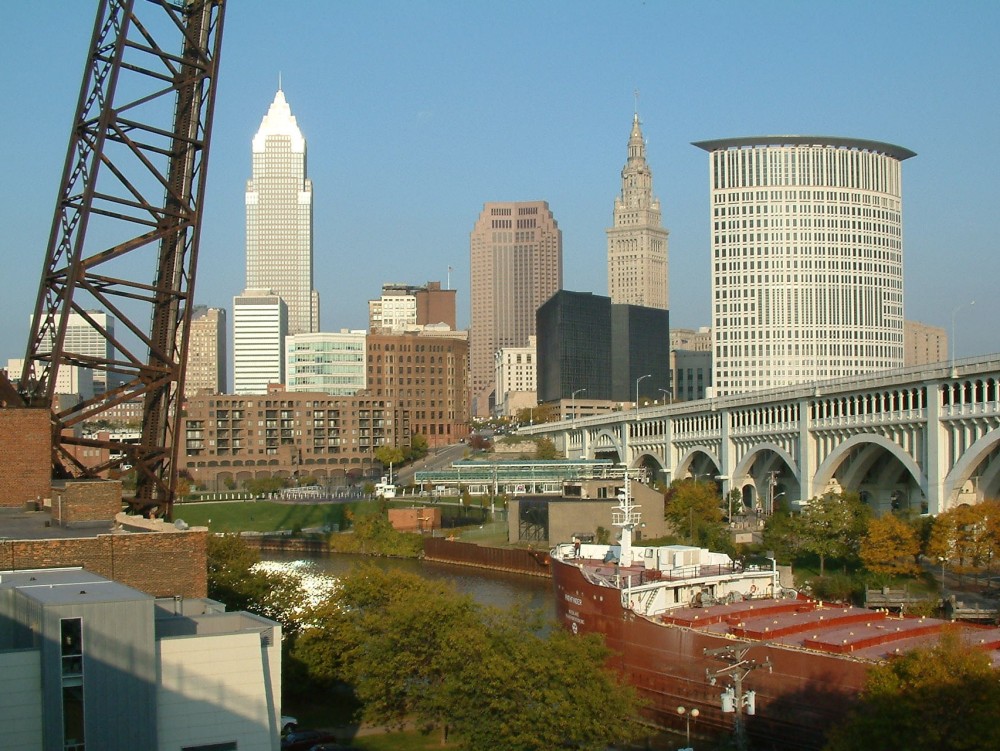
Lewis and guitarist Johnny Colla wrote an infectious song with that theme in mind — heartland, blue-collar, fist-pumpin’, rock and roll-lovin’ fans in Cleveland are the best, most passionate rock fans you’ll find. Ultimately, their manager persuaded them to make the lyrics more universal by mentioning numerous cities across the country so people anywhere could relate to it. But Lewis’s initial thought was right on the money: Cleveland and rock and roll are a pair made in heaven.
What’s up with that? How did Cleveland earn its reputation as the Rock and Roll Capital? How is it that the Rock and Roll Hall of Fame and Museum is located not in Memphis, or Philadelphia, or New York, or Los Angeles, but Cleveland, Ohio?
A number of cities have played a role in the birth, nurturing and continued support of rock and roll music since its inception in the mid-1950s, but Cleveland has been l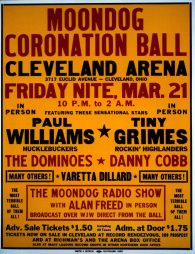 oudly and proudly involved in rock virtually every step of the way.
oudly and proudly involved in rock virtually every step of the way.
Want proof? How about this: The Moondog Coronation Ball, held at the old Cleveland Arena in 1952, is widely regarded as the very first rock concert ever staged, sponsored by…
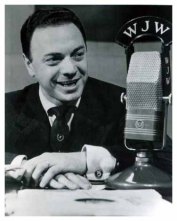 Alan Freed, the iconic disc jockey who purportedly coined (or, at the very least, first aired and popularized) the term “rock and roll,” began his radio career on WJW-AM in 1951 in Cleveland, playing rhythm-and-blues music (then known pejoratively as “race music”) to white and black audiences alike. It was Freed who sponsored the Moondog Ball before moving on to a bigger spotlight (and infamy from a payola scandal) in New York.
Alan Freed, the iconic disc jockey who purportedly coined (or, at the very least, first aired and popularized) the term “rock and roll,” began his radio career on WJW-AM in 1951 in Cleveland, playing rhythm-and-blues music (then known pejoratively as “race music”) to white and black audiences alike. It was Freed who sponsored the Moondog Ball before moving on to a bigger spotlight (and infamy from a payola scandal) in New York.
Radio brought the music to the audience, and Cleveland listeners benefited from being regarded as a test market among record companies, who were eager to try new releases in influential smaller markets before going national with them. In the Fifties and Sixties in Cleveland, Bill Randle was THE man. From his perch at WERE, he had more clout than just about anyone in the country. By the mid-’60s, it was “WIXY 1260, Super Radio” that ruled the airwaves, playing Top 40 and more to an eager audience.
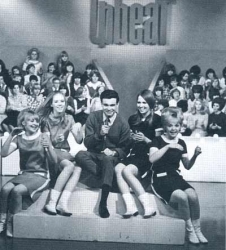 At the same time (1964-1971), Cleveland’s WEWS-TV broadcast and syndicated a rock and roll showcase called “Upbeat” that far outlasted national rock-based programs like “Shindig” and “Hullabaloo,” airing performances every week by virtually every artist (British, R&B, American, whatever) of the time period who came through town.
At the same time (1964-1971), Cleveland’s WEWS-TV broadcast and syndicated a rock and roll showcase called “Upbeat” that far outlasted national rock-based programs like “Shindig” and “Hullabaloo,” airing performances every week by virtually every artist (British, R&B, American, whatever) of the time period who came through town.
By the mid-’70s, everyone was listening to FM radio with its better signal, and in Cleveland, listeners were blessed with the formidably hip gang of DJs and program directors of WMMS-FM 100.7, which was regarded as the best rock radio station in the country for many years running. Major artists like David Bowie, Roxy Music and Bruce Springsteen all credit the ‘MMS personalities — Billy Bass, David Spero, Kid Leo, Denny Sanders, Betty Korvan, Len Goldberg and others — for helping to break them nationally.
Cleveland’s rock and roll fans were not only passionate radio listeners but also bought records in huge numbers. In downtown Cleveland, Record Rendezvous owner Leo Mintz was among the first to recognize the growing number of white teen customers who were buying R&B records in the ’50s, and consequently steered his business in that direction. More stores opened in the suburbs, and hip shops like Record Revolution in the counterculture Coventry area of Cleveland Heights, Melody Lane in Lakewood, and Music Grotto near the Cleveland State University campus flourished. The chains (Peaches, Record Theatre, Disc Records) added fuel to the fire, and by the 1970s and ’80s, Cleveland was the number one market in the US for rock music record sales.
When rock bands began hitting the road in earnest in the late 1960s and early 1970s, no tour was considered complete without a stop in Cleveland, where promoters, venues staffers, hotel managers, radio personnel, spirited groupies and hard-core fans rolled out the red carpet, eager to show them that they loved their rock and roll, and they meant business.
 As rock and roll grew exponentially around that time, so did the business interests, reach, influence and success of Jules and Mike Belkin, two Cleveland brothers who built Belkin Productions from a small concern in 1966 into the undisputed king of rock concert promotion in Cleveland and all over Ohio and the Midwest in the ’70s and ’80s and beyond. They combined efforts with most venues in the area to bring thousands of concert opportunities to Clevelanders for many decades.
As rock and roll grew exponentially around that time, so did the business interests, reach, influence and success of Jules and Mike Belkin, two Cleveland brothers who built Belkin Productions from a small concern in 1966 into the undisputed king of rock concert promotion in Cleveland and all over Ohio and the Midwest in the ’70s and ’80s and beyond. They combined efforts with most venues in the area to bring thousands of concert opportunities to Clevelanders for many decades.
Cleveland offered a rich, broad array of venues for bands at every stage of popularity. The top acts played Public Hall or Music Hall downtown, or later, the Richfield Coliseum south of town. Blossom Music Center, one of the nation’s first outdoor amphitheaters, opened in 1968 and still hosts many dozens of shows annually more than 50 years later. In the 1970s, the old Cleveland Municipal Stadium was the home of The World Series of Rock, a series of multi-act concerts that drew upwards of 75,000 fans. In the early days, clubs like the Chesterland Hullabaloo catered to an under-age crowd with notable acts of the era. Leo’s Casino brought in the top R&B acts of the day. The grand old Allen and Palace theatres in Playhouse Square have hosted many concerts. There was the theater-in-the-round Front Row Theatre. There was Peabody’s in the Flats, the Euclid Tavern in University Circle, the Phantasy Nite Club in Lakewood, the Empire downtown… And so many more that came and went, in the suburbs and outlying areas over the years…
Easily the most influential, most prized, most famous concert venue in Cleveland was The Agora Ballroom (and its basement-level second stage, The Mistake), where pioneering impresario Hank LoConti brought in countless major and minor bands (from Dire Straits to ZZ Top, from Yes to Springsteen, from Todd Rundgren to Alice Cooper) to play to packed audiences night after night in the sweaty, vibrant, authentically rock venue. It ranked with the West Coast’s Avalon Ballroom, Fillmore and The Roxy, and New York’s The Bottom Line and Max’s Kansas City as the club every band longed to play.
Curiously, Cleveland hasn’t exactly been a fertile breeding ground for musical acts that made it big on a national scale. While the region was full of excellent local/regional bands that had rabid followings in the clubs and venues there — Glass Harp, Beau Coup, Fayrewether, Death of Samantha, Damnation of Adam Blessing, Love Affair, American Noise, Tiny Alice, Wild Horses, Deadly Earnest, Nitebridge — only a handful of musicians went on to widespread notoriety.
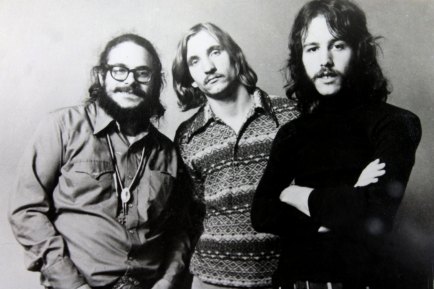 Mentioned most often is guitar hero Joe Walsh, who attended Kent State and honed his chops in clubs and bars around Cleveland and Northeast Ohio. He joined The James Gang in 1968 and was largely responsible for them winning a record contract, releasing hit albums and singles, and gaining the attention of luminaries like Pete Townshend. Walsh, of course, then went on to international success as a solo artist, member of The Eagles, and session guitarist on dozens of other artists’ recordings over a 50-year career.
Mentioned most often is guitar hero Joe Walsh, who attended Kent State and honed his chops in clubs and bars around Cleveland and Northeast Ohio. He joined The James Gang in 1968 and was largely responsible for them winning a record contract, releasing hit albums and singles, and gaining the attention of luminaries like Pete Townshend. Walsh, of course, then went on to international success as a solo artist, member of The Eagles, and session guitarist on dozens of other artists’ recordings over a 50-year career.
Also notable were The Raspberries, now often regarded as the first “power pop” group, playing engaging Beatles-like rock and pop in the 1970-1974 period, led by the voice and songs of Eric Carmen, who was born and raised in the Cleveland suburbs. Carmen’s solo career in the late ’70s and ’80s included a half-dozen Top Five singles and a huge following here and abroad.
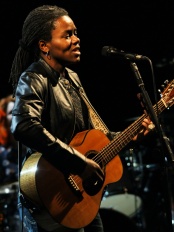
SONY DSC
The multi-talented Tracy Chapman came out of one of Cleveland’s tough inner-city neighborhoods and, thanks to the “A Better Chance” program, lifted herself out of poverty and to the opportunities presented at Tufts University in Boston. She was discovered playing coffeehouses there, and her 1988 debut album and hit song “Fast Car” helped her win the Best New Artist Grammy that year. She has enjoyed broad critical acclaim for her eight albums of original material, including the Grammy-winning song “Give Me One Reason” in 1995.
Playing piano on Chapman’s second album was Marc Cohn, another product of Cleveland’s eastern suburbs, who went on to fame himself by also winning the Best New Artist Grammy, in 1991, due to his hugely popular piano hit “Walking in Memphis,” a Song of the Year Grammy nominee. He has released a half-dozen strong albums in the singer-songwriter genre over the past two decades.
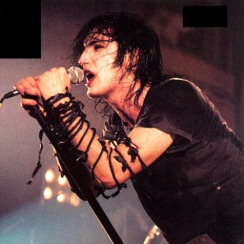 Nine Inch Nails, led by eccentric visionary Trent Reznor, got their start in Cleveland in 1988 and went on to chart a half-dozen Top Five albums in the ’90s and beyond. Reznor still tours and records today with a revolving lineup of supporting players.
Nine Inch Nails, led by eccentric visionary Trent Reznor, got their start in Cleveland in 1988 and went on to chart a half-dozen Top Five albums in the ’90s and beyond. Reznor still tours and records today with a revolving lineup of supporting players.
A Cleveland punk band known as Frankenstein found local audiences to be indifferent to punk rock and left in 1976 for New York City, where they became The Dead Boys, led by Stiv Bators, and ranked right up there with The Ramones, Blondie, Television and The Dictators in the New York punk rock scene of the late ’70s.
Emanating from Cleveland’s east side near Shaker Heights was The Dazz Band, the talented funk group that enjoyed success on R&B and Top 40 charts in the early ’80s, especially Grammy-winning #5 hit “Let It Whip” in 1982.
Pere Ubu was a Cleveland-based “avant-garage” band that “celebrated ’50s and ’60s garage rock and surf music as seen through a fun-house mirror,” as one critic put it. They formed in 1975 and made more than a dozen albums over the next 40 years which, while not commercial hits, were critical favorites.
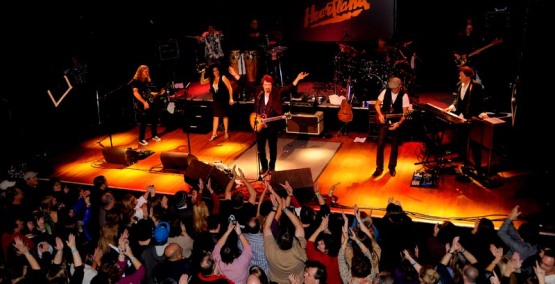 Cleveland’s favorite homegrown band by far was the Michael Stanley Band, a polished Midwest rock band with a compelling sound and great songs who inexplicably didn’t break through nationally, except for two underperforming singles (“He Can’t Love You” at #33 in 1980 and “My Town” at #33 in 1983). Between 1973 and 1983, Stanley and his band made nine solid albums that were every bit as good as, and better than, other national acts of that genre. MSB still holds records for sell-out show attendance records at several Cleveland venues.
Cleveland’s favorite homegrown band by far was the Michael Stanley Band, a polished Midwest rock band with a compelling sound and great songs who inexplicably didn’t break through nationally, except for two underperforming singles (“He Can’t Love You” at #33 in 1980 and “My Town” at #33 in 1983). Between 1973 and 1983, Stanley and his band made nine solid albums that were every bit as good as, and better than, other national acts of that genre. MSB still holds records for sell-out show attendance records at several Cleveland venues.
In the mid-’80s, when national movers and shakers in the music business announced plans for a Rock and Roll Hall of Fame and Museum, there were conflicting views as to where such an attraction should be located. Some said Memphis; others lobbied for San Francisco; still others thought Philadelphia; and, of course, New York and Los Angeles because of their size and wealth. The board members were inclined to go with New York, but Cleveland civic leaders and radio execs put on a full-court press to sell the city as the appropriate place for the museum. This included a visit to Cleveland by board members to see potential sites and hear how passionate Clevelanders were about playing host to the facility.
The deciding factor turned out to be a USA Today poll, where readers were encouraged to phone in their votes for the most deserving city. The response was overwhelming — the largest response ever to a newspaper phone-in poll — and it was also incredibly one-sided: Cleveland garnered 110,000 votes, and in second place was Memphis with a paltry 7,200. That level of enthusiasm by the people of Cleveland — the rock music lovers who already recognized their town as the rock and roll capital — tipped the scales.
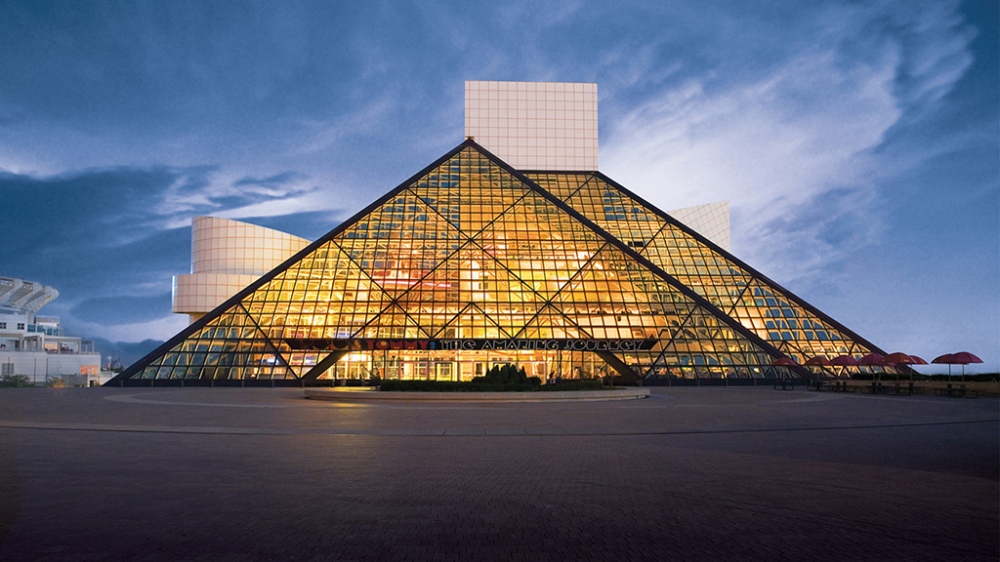 It took another nine years, but the Hall of Fame building — a visually dramatic structure (designed by I.M. Pei) on Cleveland’s lakefront — opened in 1995, with a spectacular all-star rock concert at the now-razed Cleveland Stadium next door, featuring dozens of the biggest names in the business. It was, and continues to be, a huge victory for Cleveland and its connection to rock and roll.
It took another nine years, but the Hall of Fame building — a visually dramatic structure (designed by I.M. Pei) on Cleveland’s lakefront — opened in 1995, with a spectacular all-star rock concert at the now-razed Cleveland Stadium next door, featuring dozens of the biggest names in the business. It was, and continues to be, a huge victory for Cleveland and its connection to rock and roll.
Probably the definitive and certainly most exhaustive book about Cleveland’s rock credentials and history is Deanna Adams’s 600-page Rock ‘n’ Roll and the Cleveland Connection, (Kent State University Press, 2002). Sprinkled with vintage photos and brimming over with quotes from most of the key figures in Cleveland’s rock music scene, the book is a fascinating read for any Cleveland rock fan and, indeed, for any fan of rock music history anywhere.
I must say, I find it curious that there seem to be so few rock songs that reference Cleveland. I went digging and came up with only a handful: “Cleveland Rocks,” Ian Hunter, 1979; “Look Out Cleveland,” The Band, 1969; “Cleveland,” Jewel, 2001. There are two about the city’s infamous burning river: Randy Newman’s “Burn On” (1970) and R.E.M.’s “Cuyahoga” (1986). Others are really about nearby cities, like Springsteen’s “Youngstown” (1995), or The Pretenders’ “My City Was Gone” (1985), about Cuyahoga Falls, Ohio; or, of course, Crosby Stills Nash & Young’s “Ohio” (1970), about the shootings in Kent, Ohio.
There’s the occasional lyrical reference too. You may have noted, for instance, that in Gordon Lightfoot’s #1 ode, “The Wreck of the Edmund Fitzgerald,” the freighter’s destination on that fateful journey was…Cleveland.
I’ve assembled a playlist of songs by Cleveland-based acts, from Alex “Skinny Little Boy” Bevan to Damnation of Adam Blessing, and I think you’ll be pleased by what you hear by the early James Gang, the Raspberries and the fabulous Michael Stanley Band. If you listen closely at the end of the Huey Lewis hit, God bless him, he wrapped up the tribute to rock and roll by concluding that its heart was indeed “still beating…in Cleveland…”
Nice piece Hack. Also in 1969, Led Zepplin and James Gang played Musicarnival. WMMS also launched Rush here in the states.
LikeLiked by 1 person
Excellent Hack! Thanks for spreading the word that Cleveland, in fact, does Rock!
LikeLiked by 1 person
Hell yeah!
LikeLike
Great piece to set the record straight. I think that Brits could quibble and say that London (or even Liverpool) would beat out Cleveland, but looking at it from an American perspective, it’s a LeBron slam dunk.
You forgot one notable artist. Although born in Akron, that seems close enough in my book to include Chrissie Hynd of the Pretenders.
LikeLiked by 1 person
I did mention The Pretenders’ song “My City Was Gone” among the songs that are about cities near Cleveland (Cuyahoga Falls)…
LikeLike
Enjoyed the article. FYI…regarding the USA Today poll…we cheated. I mean we REALLY cheated. But, that’s rock n roll.
LikeLike
Thanks for the kind words, Joe. Don’t know if we cheated (it seems possible, certainly), but I know WMMS cheated one year t9o win Best FM Radio Station in Rolling Stone’s poll… As you say, it’s only rock ‘n roll…and I like it!
Btuce
LikeLike
Excellent piece on the history of Cleveland rock n roll Bruce. You pretty much covered all the bases. I just wanted to add the fact that The Pretenders very first song, on their first album ‘Precious”, is about Cleveland. Chrissie is telling you about her experiences; “ridin’ down the Shoreway”, and stuff. And don’t forget the bands Mr. Stress, Wild Giraffes, and guitarist Neil Giraldo, the husband of Pat Benatar.
LikeLike
Thanks for your kind words, David. Yes, I forgot Mr. Stress, how negligent of me… And a shout-out to Parma’s Neil Giraldo was also in order… Didn’t know that The Pretenders’ “Precious” was about Cleveland, only that “My City Was Gone” was about Cuyahoga Falls, where C. Hynde spent her formative years…
LikeLike
Overdue Kudos on our old hometown rock hit-story!
The Baskerville Hounds did a publicity photo shoot in the windows of the stone Tudor house near the corner of EdgeHill / Overlook
and Derbyshire @1967.
LikeLike